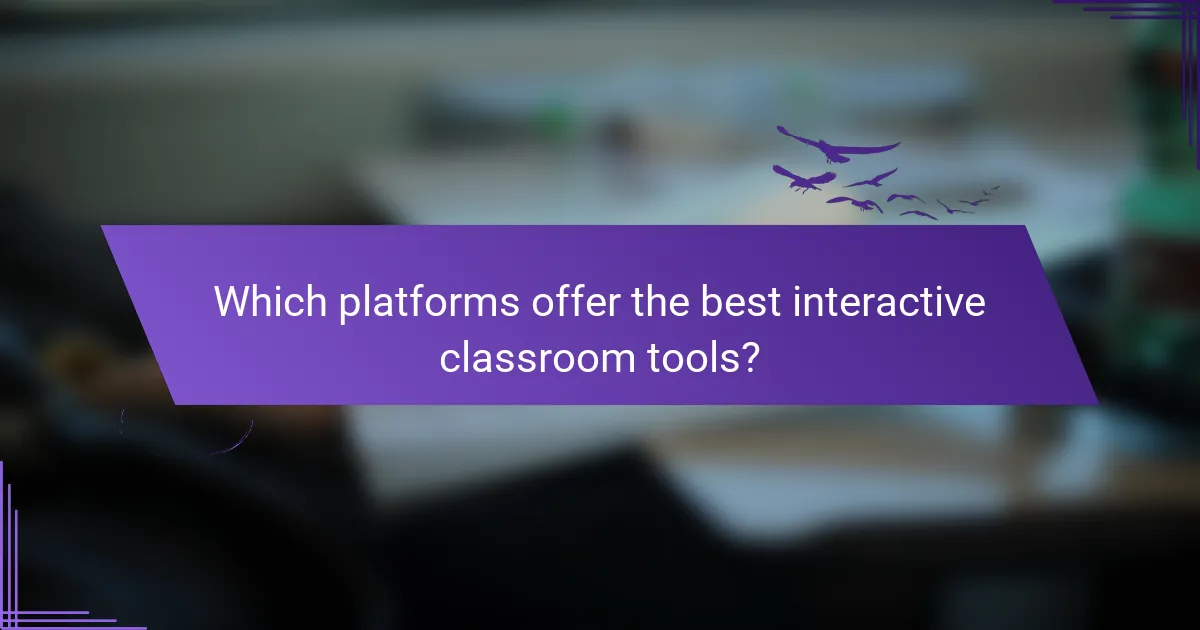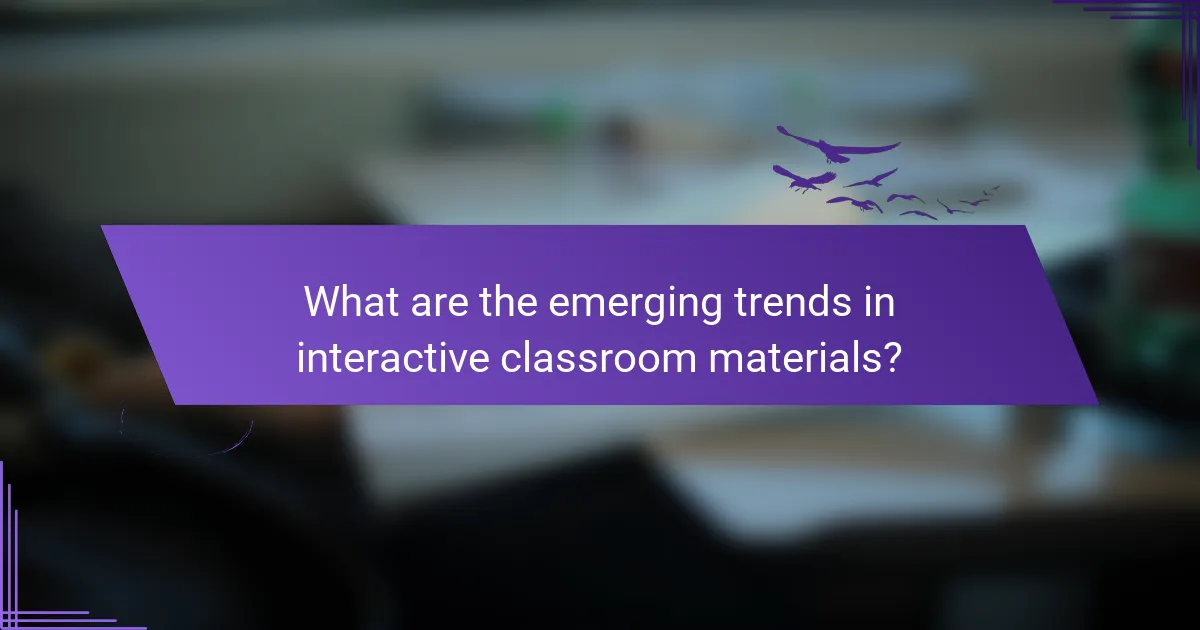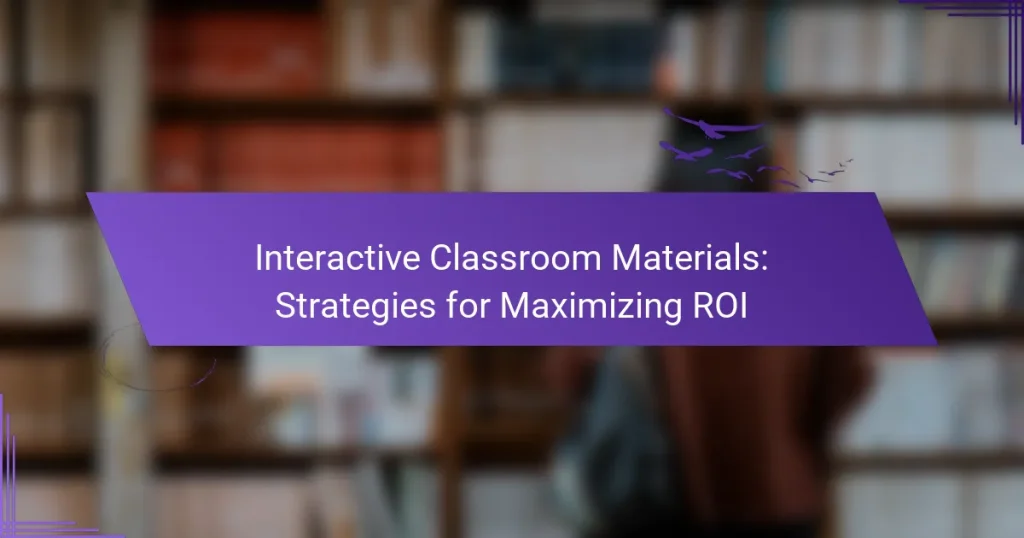Interactive classroom materials play a crucial role in maximizing the return on investment (ROI) for online courses by boosting student engagement and retention. By leveraging strategies such as gamification, real-time feedback, and collaborative activities, educators can create a dynamic learning environment that enhances educational outcomes and optimizes resource utilization.

How can interactive classroom materials improve ROI in online courses?
Interactive classroom materials can significantly enhance the return on investment (ROI) in online courses by increasing student engagement and retention. By incorporating elements like gamification, quizzes, and effective resource management, educators can create a more impactful learning experience that leads to better outcomes and cost savings.
Enhanced engagement through gamification
Gamification involves integrating game-like elements into educational content, which can boost student engagement. Techniques such as point systems, badges, and leaderboards encourage participation and competition, making learning more enjoyable. For instance, using a points system for completing assignments can motivate students to engage more actively with the course material.
To implement gamification effectively, consider setting clear objectives and rewards that align with learning goals. Avoid overly complex systems that may confuse students; simplicity often leads to better engagement. Regularly update challenges to maintain interest and excitement throughout the course.
Increased retention via interactive quizzes
Interactive quizzes serve as a powerful tool for reinforcing knowledge and improving retention rates among students. By providing immediate feedback, quizzes help learners identify areas for improvement and reinforce concepts. Research suggests that well-designed quizzes can enhance retention by up to 50% compared to traditional methods.
Incorporate a variety of quiz formats, such as multiple-choice, fill-in-the-blank, or scenario-based questions, to cater to different learning styles. Schedule quizzes at regular intervals to maintain momentum and encourage consistent study habits. Ensure that quizzes are aligned with course objectives to maximize their effectiveness.
Cost-effective resource allocation
Using interactive materials can lead to more efficient resource allocation in online courses. Digital resources often require lower upfront costs compared to traditional materials, such as textbooks and printed handouts. Additionally, interactive tools can be reused across multiple courses, further reducing expenses.
Evaluate the cost-effectiveness of various interactive tools by considering factors like licensing fees, maintenance costs, and the potential for scalability. Opt for open-source or free platforms when possible to minimize expenses. Regularly assess the impact of these resources on student performance to ensure they provide value for the investment.
Measurable learning outcomes
Interactive classroom materials facilitate the measurement of learning outcomes, allowing educators to assess the effectiveness of their teaching strategies. By using analytics tools, instructors can track student progress and engagement levels, providing insights into areas that may need improvement.
Establish clear metrics for success, such as completion rates, quiz scores, and participation levels. Use these metrics to inform instructional adjustments and enhance the overall learning experience. Regularly review and analyze data to ensure that interactive materials are meeting educational goals and contributing to a positive ROI.

What strategies maximize the effectiveness of interactive materials?
To maximize the effectiveness of interactive materials, focus on integrating diverse multimedia resources, facilitating real-time feedback, and designing collaborative activities. These strategies enhance engagement and learning outcomes, ensuring that educational investments yield significant returns.
Utilizing multimedia resources
Incorporating multimedia resources such as videos, animations, and interactive simulations can significantly enhance the learning experience. These tools cater to various learning styles, making complex concepts more accessible and engaging for students.
When selecting multimedia, consider the relevance and quality of the content. Aim for resources that align with learning objectives and are visually appealing. For instance, a short video explaining a scientific principle can be more effective than a lengthy textbook chapter.
Incorporating real-time feedback
Real-time feedback allows students to understand their performance immediately, fostering a growth mindset. Tools like quizzes with instant results or interactive polling can provide valuable insights into student comprehension.
To implement this strategy, use platforms that support instant feedback mechanisms. For example, online quiz tools can show correct answers right after submission, helping students learn from mistakes without delay. Ensure that feedback is constructive and encourages further inquiry.
Designing collaborative activities
Collaborative activities promote teamwork and communication skills among students. By designing group projects or peer review sessions, educators can create an interactive environment that encourages active participation and collective problem-solving.
When planning these activities, consider the group dynamics and the objectives of the task. Assign roles within groups to ensure accountability and engagement. For example, using breakout rooms in virtual classrooms can facilitate small group discussions, enhancing the collaborative experience.

Which platforms offer the best interactive classroom tools?
Several platforms provide excellent interactive classroom tools, each with unique features that enhance student engagement and learning outcomes. Google Classroom, Kahoot!, and Nearpod are among the top choices for educators looking to maximize their return on investment (ROI) in interactive materials.
Google Classroom for seamless integration
Google Classroom offers seamless integration with other Google services, making it easy for educators to manage assignments, communicate with students, and share resources. This platform is particularly beneficial for schools already using Google Workspace, as it streamlines the workflow and reduces the need for additional training.
To maximize its effectiveness, educators should utilize Google Classroom’s features such as assignment scheduling, real-time feedback, and integration with tools like Google Docs and Sheets. This allows for a more organized approach to lesson planning and student collaboration.
Kahoot! for engaging quizzes
Kahoot! is a game-based learning platform that allows teachers to create engaging quizzes and interactive games that can be played in real-time. This tool is particularly effective for formative assessments, as it encourages participation and can provide immediate feedback to both students and teachers.
To get the most out of Kahoot!, educators should focus on crafting questions that are aligned with learning objectives and consider using a mix of question types, such as multiple-choice and true/false. Regularly updating quizzes keeps content fresh and maintains student interest.
Nearpod for interactive lessons
Nearpod enables educators to create interactive lessons that incorporate multimedia elements, quizzes, and polls, fostering an engaging learning environment. This platform allows for real-time assessment and feedback, making it easier to gauge student understanding during lessons.
For effective use of Nearpod, teachers should explore its library of pre-made lessons and customize them to fit their curriculum. Incorporating interactive elements such as VR experiences or collaborative boards can significantly enhance student engagement and learning retention.

What are the prerequisites for implementing interactive materials?
Implementing interactive materials requires a clear understanding of the learner demographics, access to technology, and adequate training for instructors. These prerequisites ensure that the materials are effective and accessible for all students.
Understanding learner demographics
Recognizing the demographics of your learners is crucial for tailoring interactive materials to their needs. Factors such as age, learning styles, and cultural backgrounds can significantly influence how students engage with content.
For example, younger learners may prefer gamified experiences, while adult learners might benefit from practical applications. Conduct surveys or assessments to gather data on your students’ preferences and backgrounds to inform your material development.
Assessing technology access
Evaluating the technology access of your learners is essential for successful implementation of interactive materials. Consider whether students have reliable internet access, suitable devices, and the necessary software to engage with the materials.
In regions with limited technology, consider hybrid models that incorporate both digital and traditional resources. A simple checklist can help assess access: availability of devices, internet speed, and familiarity with required software.
Training instructors on new tools
Training instructors on the new interactive tools is vital for maximizing their effectiveness in the classroom. Instructors should be comfortable using the technology and understand how to integrate it into their teaching strategies.
Offer professional development sessions that focus on hands-on practice with the tools, along with strategies for engaging students. Encourage instructors to share best practices and challenges they encounter to foster a collaborative learning environment.

How do interactive materials compare to traditional methods?
Interactive materials generally outperform traditional methods by fostering greater student engagement and enhancing learning outcomes. They leverage technology to create dynamic learning environments that cater to diverse learning styles.
Higher engagement rates
Interactive materials significantly boost engagement rates compared to conventional teaching methods. Tools like quizzes, simulations, and gamified learning experiences encourage active participation, making lessons more enjoyable and memorable.
For example, classrooms that incorporate interactive whiteboards or educational apps often see students participating more actively, leading to increased enthusiasm and motivation. This heightened engagement can translate into improved attendance and participation rates.
Better knowledge retention
Students using interactive materials tend to retain information better than those relying solely on traditional lectures. The hands-on experience and immediate feedback provided by interactive tools help reinforce learning and facilitate deeper understanding.
Research indicates that learners engaged in interactive activities can recall information more effectively, often retaining knowledge for longer periods. Techniques such as spaced repetition and interactive assessments can further enhance retention rates.
More personalized learning experiences
Interactive materials allow for more personalized learning experiences, catering to individual student needs and preferences. Adaptive learning technologies can assess a student’s progress and adjust the difficulty level of tasks accordingly.
This personalization can be particularly beneficial in diverse classrooms, where students may have varying levels of understanding. By using interactive platforms that offer tailored content, educators can ensure that each student receives the support they need to succeed.

What are the emerging trends in interactive classroom materials?
Emerging trends in interactive classroom materials focus on enhancing student engagement and personalizing learning experiences. Innovations such as AI-driven tools, gamification, and collaborative platforms are reshaping how educators deliver content and assess understanding.
AI-driven personalized learning
AI-driven personalized learning tailors educational experiences to individual student needs, preferences, and learning paces. By analyzing data from student interactions, these systems can recommend resources, adjust difficulty levels, and provide targeted feedback, fostering a more effective learning environment.
Implementing AI in the classroom requires careful consideration of available tools and their integration into existing curricula. Popular platforms often include features like adaptive assessments and real-time analytics, which help educators track progress and adjust instruction accordingly.
To maximize the benefits of AI-driven personalized learning, educators should focus on selecting tools that align with their teaching goals and student demographics. It’s essential to provide adequate training for both teachers and students to ensure smooth adoption and to avoid common pitfalls such as over-reliance on technology or neglecting face-to-face interactions.


